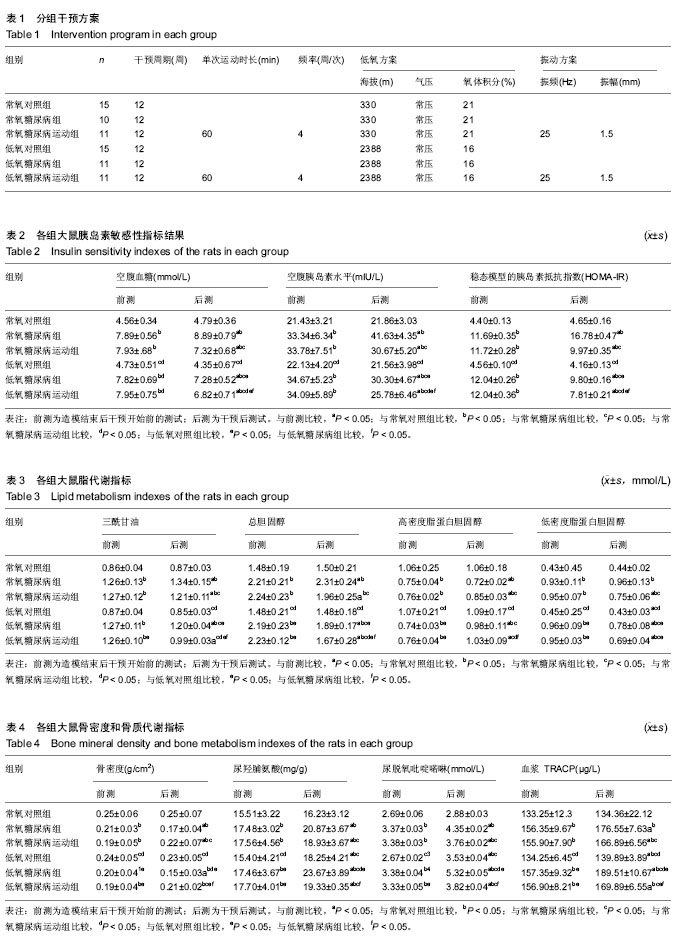| [1] Xu Y,Wang L,He J,et al.Prevalence and control of diabetes in Chinese adults.JAMA.2013;310(9) : 948-959.[2] Unwin N,Shaw J,Zimmet P,等.糖耐量低减和空腹血糖受损:定义及干预的现状[J].中华内分泌代谢杂志,2003(1):1-8.[3] 陈璐,陈适,许可,等.糖尿病患者行为方式与血糖控制关系[J]中国公共卫生,2017,33(10):1501-1503.[4] 周吉.南宁市35岁以上2型糖尿病患者血糖控制现状及影响因素分析[J].中华疾病控制杂志,2014,18(9) : 816- 819.[5] 张荷,周越,张一民,等,低氧运动对肥胖大鼠胰岛素抵抗及血脂代谢的影响[J].北京体育大学学报,2016,39(9):44-49[6] Mackenzie R, Maxwell N, Castle P, et al.Acute hypoxia and exercise improve insulin sensitivity in individuals withtype 2 diabetes.Diabetes. 2011;27(1): 94-101[7] 林文弢,李颖,翁锡全.间歇性低氧和运动对高脂饮食诱导胰岛素抵抗大鼠血清内脂素的影响[J].中国运动医学杂志,2008,27(2):161-164[8] 刘一平,刘丽霞, 韦立新,运动干预对糖耐量减低患者血清抵抗素与胰岛素敏感性的影响[J]北京体育大学学报, 2007,30(10):1362-1377.[9] Kurto?lu S, Hatipo?lu N, Maz?c?o?lu M, et al.Insulin resistance in obese children and adolescents:HOMA –IRcut -off levels in the prepubertal and pubertal periods. J Clin Res Pediatr Endocrinol.2010; 2(3):100-106.[10] 王宁琦,胡扬,官余凌,等.4周低氧运动结合饮食控制对肥胖青年体重、血脂及胰岛素抵抗的影响[J].中国运动医学杂志 2012,31(4):289-294.[11] Yin H, Berdel HO, Moore D, et al.Whole body vibration therapy: a novel potential treatment for type 2 diabetes mellitus.Springerplus. 2015;4:578.[12] Liu Y, Zhai M, Guo F, et al.Whole Body Vibration Improves Insulin Resistance in db /db Mice: Amelioration of Lipid Accumulation and Oxidative Stress.Appl Biochem Biotechnol. 2016 Jul;179(5):819-829.[13] 刘影,刘涛,李星.振动训练对2型糖尿病大鼠肝脏 SREBP-1c蛋白表达的影响[J].现代预防医学,2015,42( 8 ): 1468-1471.[14] 齐洁.游泳运动对高脂饮食大鼠胰岛素抵抗的影响及作用机制[D].扬州: 扬州大学,2014.[15] Liu X,He X,Li L,et al.Influence of continuous nursing on the psychological state and coping style of patients undergoing pacemaker implantation.Iran J Public Health.2015;44(7):953-961.[16] Berschin G, Sommer B, Behrens A,et al.Whole body vibration exercise protocol versus a standard exercise protocolafter ACL reconstruction: A clinical randomized controlledtrial with short term follow-up. J Sports Sci Med.2014;13(3): 580-589.[17] Stevens AL, Ferferieva V, Bito V, et al.Exercise improves cardiac function and attenuates insulin resistance in Dahl salt-sensitive rats.Int J Cardiol.2015;186:154-160.[18] 谢宜轩,李帅东. 持续和间歇低氧运动对肥胖大鼠体重及相关代谢指标的影响[J].扬州大学学报(自然科学版), 2016,37(1):31-34.[19] Tan J, Mo H, Li J, et al.Effects of chronic intermittent hypoxia on glucose transporter 4 expression in rat skeletal muscles.Nan Fang Yi Ke Da Xue Xue Bao.2014;34(7):1061-1064.[20] 杨春,刘英伟,贾玥. 全身振动训练对胰岛素抵抗大鼠 Ir症状及脂肪代谢影响的实验研究[J].沈阳体育学院学报, 2016,35(3):75-78.[21] 刘晓东,邓廉夫,王君,等.低氧诱导因子-1α 在绝经后骨质疏松中调控作用的实验研究[J].中华外科杂志,2007,45(18): 1274-1278.[22] Siervo M, Riley HL, Fernandez BO,et al.Effects of prolonged exposure to hypobaric hypoxia on oxidative stress,inflammation and gluco-insular regulation: the not-so-sweet price for good regulation. PLoS One.2014;9(4) : 1-10.[23] 乔林,白峰,赵轶男,等. 低氧环境下去势大鼠骨质疏松模型的骨吸收标志物观察[J], 科学技术与工程,2014,14(7):1671-1815.[24] Li M,Wu W,TanL,et al.Low-magnitude mechanical vibration regulates expression of osteogenic proteins in ovariectomized rats.Biochem Biophys Res Commun.2015;465(3):344-348.[25] Chen GX, Zheng S, Qin S, et al.Effect of low-magnitude wholebody vibration combined with alendronate in ovariectomized rats:a random controlled osteoporosis prevention study.PLoS One.2014;9(5) : e96181. |



